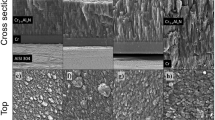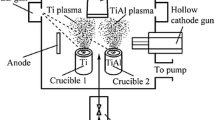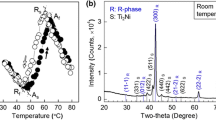Abstract
This paper presents a fabrication and characterization of multilayered microstructures with shape memory effects enabling large vertical deployment under electro-thermal actuation. Our previous research demonstrated vertical deployment of such microstructures by the effect of thermal mismatch. Development of equiatomic NiTi layers in the multilayered microstructure is investigated further for shape memory effects. Multilayered microstructures are built by sputtered NiTi layers and a lift-off process. Negative photoresist ma-N1420 enables clean lift-off of 500 nm thick NiTi layers by forming a significant undercut profile after development. The parametric study on co-sputter powers for Ti and Ni50Ti50 targets suggests that 100 W RF on Ti target and 200 W DC on Ni50Ti50 target can deposit Ni49.62Ti50.38 layers. X-Ray Diffraction (XRD) and Atomic Force Microscopy (AFM) were used to study the crystal structures and surface topography of NiTi layers. XRD results of post-annealed Ni49.62Ti50.38 layers show coexistence of austenite and martensitic phases at room temperature, suggesting that the transformation temperature of such NiTi layers should be approximate 20 °C. The surface topography of Ni49.62Ti50.38 layers reveals substantial increase of surface roughness at ambient conditions after the annealing. Experimental verification of the multilayered microstructure for vertical deployment was carried out by Signatone Probe Station and Dual Scanning Electron Microscope/Focused Ion Beam (SEM/FIB) system. A vertical deployment of the two-dimensional (2D) multilayered microstructures for three-dimensional (3D) can be detected by applying a constant voltage of 0.04 V, and the expected 3D deployment displacement is enlarged from 2 μm to 10 μm by introducing the shape memory effect.








Similar content being viewed by others
References
Choudhary N, Kaur D (2016) Shape memory alloy thin films and heterostructures for MEMS applications: a review sensors and actuators A. Physical 242:162–181
Craciunescu C, Ercuta A (2014) Prediction of thermally-controlled actuation for shape memory alloy film-based bimorph cantilevers. Smart Mater Struct 23:075025
Frenzel J, George EP, Dlouhy A, Somsen C, Wagner M-X, Eggeler G (2010) Influence of Ni on martensitic phase transformations in NiTi shape memory alloys. Acta Mater 58:3444–3458
Galos R, Shi Y, Ren Z, Sun H (2017) Electrical impedance matching of PZT nanogenerators. In: ASME 2017 International Design Engineering Technical Conferences and Computers and Information in Engineering Conference. American Society of Mechanical Engineers, pp V004T009A025. https://doi.org/10.1115/DETC2017-67981
Galos R, Shi Y, Ren Z, Zhou L, Sun H, Su X, Yuan J (2017b) Electrical impedance measurements of PZT nanofiber sensors Journal of Nanomaterials 2017:8275139. https://doi.org/10.1155/2017/8275139
Galos R et al (2018) The dielectric constant of PZT nanofiber at visible and NIR wavelengths. Nano-Struct Nano-Objects 15:205–211. https://doi.org/10.1016/j.nanoso.2017.10.001
Ghazali FAM, Hasan MN, Rehman T, Nafea M, Ali MSM, Takahata K (2020) Micro-electromechanical-system actuators for biomedical applications. Rev J Micromech Microeng 30:073001
Ghosh B, Jain R, Majumder S, Roy S, Mukhopadhyay S (2017) Experimental performance evaluation of smart bimorph piezoelectric actuator and its application in micro robotics. Microsyst Technol 23:4619–4635
Jafferis NT, Smith MJ, Wood RJ (2015) Design and manufacturing rules for maximizing the performance of polycrystalline piezoelectric bending actuators. Smart Mater Struct. https://doi.org/10.1088/0964-1726/24/6/065023
Jayachandran S, Akash K, Prabu SM, Manikandan M, Muralidharan M, Brolin A, Palani I (2019) Investigations on performance viability of NiTi, NiTiCu, CuAlNi and CuAlNiMn shape memory alloy/Kapton composite thin film for actuator application. Compos B Eng 176:107182
Knick CR, Sharar DJ, Wilson AA, Smith GL, Morris CJ, Bruck HA (2019) High frequency, low power, electrically actuated shape memory alloy MEMS bimorph thermal actuators. J Micromech Microeng 29:075005
Knick CR, Smith GL, Morris CJ, Bruck HA (2019) Rapid and low power laser actuation of sputter-deposited NiTi shape memory alloy (SMA) MEMS thermal bimorph actuators. Sens Actu A 291:48–57
Liu L, Pal S, Xie H (2012) MEMS mirrors based on a curved concentric electrothermal actuator. Sens Actu A 188:349–358
Ma KY, Felton SM (2012) Design, fabrication, and modeling of the split actuator microrobotic bee. In: 2012 IEEE/RSJ international conference on intelligent robots and systems. IEEE, Germany
McClintock H, Temel FZ, Doshi N, Koh J-S, Wood RJ (2018) The milliDelta: a high-bandwidth, high-precision, millimeter-scale Delta robot. Sci Robot 3:eaar018
Najafi Sohi A, Nieva PM (2016) Frequency response of curved bilayer microcantilevers with applications to surface stress measurement. J Appl Phys 119:044503
Qiu Z, Pulskamp JS, Lin X, Rhee CH, Wang T, Polcawich RG, Oldham K (2010) Large displacement vertical translational actuator based on piezoelectric thin films. J Micromech Microeng. https://doi.org/10.1088/0960-1317/20/7/075016
Ren Z, Yuan J, Su X, Sun H, Galos R, Shi Y (2018) A new fabrication process for microstructures with high area-to-mass ratios by stiffness enhancement. In: ASME 2018 International Design Engineering Technical Conferences and Computers and Information in Engineering Conference, 2018. American Society of Mechanical Engineers, p V004T008A034. https://doi.org/10.1115/DETC2018-86282
Ren Z et al. (2019) Vertical deployment of multilayered metallic microstructures with high area-to-mass ratios by thermal actuation. J Micro Nano-Manufact 7(3):031002. https://doi.org/10.1115/1.4043987
Ren, Z, Yuan, J, Su, X et al (2020a) Thermo-mechanical modeling and experimental validation for multilayered metallic microstructures. Microsyst Technol. https://doi.org/10.1007/s00542-020-04988-2
Ren, Z, Yuan, J, Su, X et al (2020b) Electro-thermal modeling and experimental validation for multilayered metallic microstructures. Microsyst Technol. https://doi.org/10.1007/s00542-020-04964-w
Shintake J, Cacucciolo V, Floreano D, Shea H (2018) Soft robotic grippers. Adv Mater 1:e1707035. https://doi.org/10.1002/adma.201707035
Su X, Ren Z, Sun H, Shi Y, Pan Q (2018) The submicron fabrication process for T gate with a flat head. In: ASME 2018 International Design Engineering Technical Conferences and Computers and Information in Engineering Conference, 2018. American Society of Mechanical Engineers, p V004T008A018. https://doi.org/10.1115/DETC2018-85581
Su X, Ren Z, Yan J, Shi Y, Pan Q (2019) Microstructure and twisting ability of an adjusted antisymmetric angle ply laminate. Appl Phys Lett 114:211902. https://doi.org/10.1063/1.5089809
Sun H, Luo J, Ren Z, Lu M, Nykypanchuk D, Mangla S, Shi Y (2020) Shape memory alloy bimorph microactuators by lift-off process. J Micro Nano-Manufact 8(3):031003. https://doi.org/10.1115/1.4048146
Todd ST, Xie H (2008) An electrothermomechanical lumped element model of an electrothermal bimorph actuator. J Microelectromech Syst 17:213–225
Truby RL, Li S (2020) Integrating chemical fuels and artificial muscles for untethered microrobots. Sci Robot 5:3
Wongweerayoot E, Srituravanich W, Pimpin A (2015) Fabrication and characterization of nitinol-copper shape memory alloy bimorph actuators. J Mater Eng Perform 24:635–643
Wu L, Xie H (2008) A large vertical displacement electrothermal bimorph microactuator with very small lateral shift. Sens Actu A 145:371–379
Yan Z et al (2017) Three-dimensional mesostructures as high-temperature growth templates, electronic cellular scaffolds, and self-propelled microrobots. Proc Natl Acad Sci USA 114:E9455–E9464. https://doi.org/10.1073/pnas.1713805114
Zainal MA, Sahlan S, Ali MSM (2015) Micromachined shape-memory-alloy microactuators and their application in biomedical devices. Micromachines 6:879–901
Zhang Y (2016) Mechanical assembly of complex, 3D mesostructures from releasable multilayers of advanced materials. Sci Adv 2(9):e1601014
Zhang Y, Zhang F, Yan Z, Ma Q, Li X, Huang Y, Rogers JA (2017) Printing, folding and assembly methods for forming 3D mesostructures in advanced materials. Nat Rev Mater. https://doi.org/10.1038/natrevmats.2017.19
Zhong J et al (2019) A flexible piezoelectret actuator/sensor patch for mechanical human-machine interfaces. ACS Nano 13(6):7107–7116
Zolfagharian A, Kouzani AZ, Khoo SY, Moghadam AAA, Gibson I, Kaynak A (2016) Evolution of 3D printed soft actuators. Sens Actu Phys 250:258–272. https://doi.org/10.1016/j.sna.2016.09.028
Acknowledgements
The National Natural Science Foundation of China (No.11572248) and China Scholarship Council have in part supported the research. The research was in part carried out at the Center for Functional Nanomaterials (CFN), Brookhaven National Laboratory (BNL), which is supported by the U.S. Department of Energy, Office of Basic Energy Sciences, under Contract No. DE-SC0012704. The authors would like to thank Dr. Chang-Yong Nam, Dr. Fernando Camino, Dr. Tong Xiao, Dr. Samuel A. Tenney, and Ms. Gwen Wright for helping finish the materials characterization and experimental tests in CFN.
Author information
Authors and Affiliations
Corresponding authors
Additional information
Publisher's Note
Springer Nature remains neutral with regard to jurisdictional claims in published maps and institutional affiliations.
Electronic supplementary material
Below is the link to the electronic supplementary material.
Supplementary file1 (MP4 4497 KB)
Supplementary file2 (MP4 4497 KB)
Rights and permissions
About this article
Cite this article
Ren, Z., Yuan, J., Su, X. et al. Multilayered microstructures with shape memory effects for vertical deployment. Microsyst Technol 27, 3325–3332 (2021). https://doi.org/10.1007/s00542-020-05101-3
Received:
Accepted:
Published:
Issue Date:
DOI: https://doi.org/10.1007/s00542-020-05101-3




